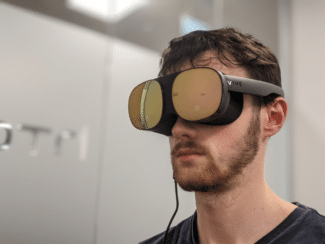HTC’s Vive Flow is by far the lightest and most comfortable VR headset I’ve ever worn.
As a regular VR user, when I first picked up Flow I instinctively put it on over my head as I would any other headset. After feeling how light it was – just 189 grams – I realized I could just slide it on as I would a pair of glasses. Flow has no top strap, because it just doesn’t need one. Though I only had 45 minutes in the demo, it felt like I could wear it all day.
The problem with the strapless design was it felt harder to get the lenses close enough to my eyes, so I had to push the device into my face a few times. Visual quality felt similar to Quest 2, but slightly dimmer. The black levels were impressive for LCD, but still clearly not OLED. The field of view was slightly narrower than larger headsets, but not by much.
HTC told us hand tracking will arrive at some point in the future, but for now Flow is controlled by your phone. Your Android phone, I should say – iPhone isn’t supported. If you’ve used Samsung Gear VR, Oculus Go, or Lenovo Mirage Solo you’ll instantly be familiar with the input scheme. The phone acts as a rotational laser pointer, but isn’t positionally tracked so just hovers in place below you. The disconnect between where your phone really is and where it’s shown can be fairly frustrating, and not an input modality I expected to return to VR after Go’s retirement.
The headset positional tracking is a great addition compared to something like Go, but didn’t feel as solid as other VR headsets. That may have been due to the myriad of reflective and transparent surfaces in the demo room though.

When using Flow your phone acts as a touch surface divided into four sections. Tap the bottom to select, the top for menu, and the sides for left and right. The lack of tactile buttons meant I frequently tapped the wrong area and you need to look down to see what you’re doing wrong, but by the end of the demo it wasn’t really an issue.
Vive Flow occupies a weird middle ground between fully standalone and tethered. While the phone input is wireless, the headset itself is not. The computing is done onboard, but the internal battery is tiny, only intended to prevent the device shutting off if you accidentally unplug it from your battery – which I did while immersed in the demo content (you’re greeted with a countdown to standby), though better positioning of your battery could avoid this.
Flow’s special sauce is the ability to easily and wirelessly show and control your phone screen on a massive virtual screen. It even supports HDCP, so you can use apps like Netflix and Disney+. Phone casting is easily the most compelling feature of Flow, something sorely missing from Oculus Go. It was truly seamless, it didn’t feel like a hack or workaround in any way. The audio quality was surprisingly good given the tiny speakers in the arms, and bluetooth earphones are supported for private listening.
Trying native VR apps was far less impressive. They launched quickly, but none of those installed seemed to actually be maintaining 75 frames per second. I was using non-final software though, so it’s possible this will be solved by launch. HTC wouldn’t tell us what processor is inside Flow, but I suspect it’s Qualcomm’s XR1, which is much less powerful than the XR2 found in Oculus Quest 2.

Many will be making direct comparisons to Quest 2, but I actually don’t think they directly compete. If you want to play VR games you’d be a fool to pick Flow, but if the reason you want a headset is to have a personal cinema screen it simply blows Quest 2 out of the water. Flow’s real competition is transparent media glasses like Nreal Air, though that device category hasn’t made it to most western markets yet.
Flow reminded me of Oculus Go far more than of Quest. Facebook seems to think the problem with Go was the lack of Touch controllers, but I’m not so sure. Go as a media viewer wasn’t a bad idea, it was just badly executed. It was too heavy for long viewing sessions and the lack of positional tracking just felt downright uncomfortable. Vive Flow solves both of these problems and given the similar use cases and input schemes, it feels like Go’s spiritual successor.







